Audio Vaccine Music Serum
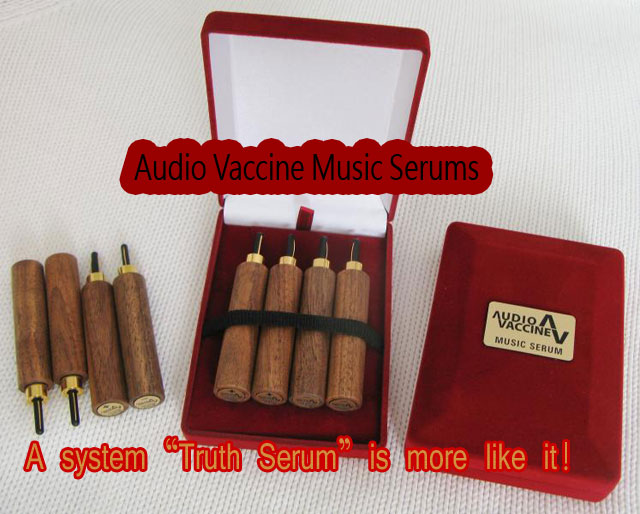


The variety of high-end audio tweaks has grown tremendously over the past decade, thanks in a large part to the Internet. And at great venues like Denver’s AudioFest, the Newport and Munich high end shows, their presence—along with some pretty outlandish claims—have become routine.
To some high-brow, armchair skeptics, manufacturers of tweaks are nothing but B.S. salesmen and their products snake oil perpetuated by people like me, who enjoy experimenting and writing about them.Truth is, I don’t like B.S. either, and I don’t know anyone who does. In my formative years I too was an armchair skeptic—a person who judges a product as a hoax without ever hearing it. Ignorance is, I suppose, a sort of blinkered bliss.
A chance encounter with Jack Bybee changed all this. In one fell swoop, he opened my ears to a level of detail and fidelity I would have never believed possible from an audio system.
The fact is that most folks in our industry simply do not endorse tweaks. You hardly ever will find tweaks featured in any of the major audiophile publications. And for a good, though perhaps cynical, reason: why sell a $2,000 tweak when there is much more profit to be made on a $20,000 component? This is the reason we’ll invariably find a new, sleek black and chrome (and expensive) component on the cover of AudioFool magazine…instead of a set of Stein Harmonizers.
Granted, I have come across tweaks that, to my ears, produced absolutely no difference. Worse, I’ve experienced tweaks that actually made my system sound worse. The highly-touted Quantum AC Plugs seemed to increase the low level noise rather than lower it. The Synergistic Research Bowls made my ears ring. The Audio Magic Oracle 24 AC enhancer worsened my system’s overall performance. Products all recommended by people whose ears I trust. I know of no scientific explanation why Mr X finds a certain tweak amazing and I don’t. Clearly, audiophiles have personal preferences, prejudices and limitations, which is why it is important to always try before you buy. Just as you would with an amplifier, loudspeaker or AC powercord.
Cases in point: over ten years ago Franck Tchang introduced his Acoustic Resonators and extolled the importance of proper harmonic resonances. Acoustic Revive’s RR-77 device, based on the Schumann Frequency, worked wonders in my dedicated room. Stein Harmonizers and Magic Stones proved to me just how effective passive devices can be. They purport to work by making the air molecules more compliant. Similarly, the IPC products from China took many of us here by storm (and they’re based on the same principle as the Stein Harmonizers). The sonic improvements they make are passionate, powerful and panoramic. Lastly, I am having an intense love affair with Entreq and their latest grounding devices. What these devices did for my system is nothing short of awe inspiring. Crazy, I know. Oh, and yes, each are presently working arm in arm in my upstairs listening room.
Finding the right tweaks?
Tweaks that really work with your system can be an absolutely divine experience. I am convinced that tweaks like those mentioned above have the ability to take a system to sonic heights seldom achieved by the purchase of the latest and greatest components.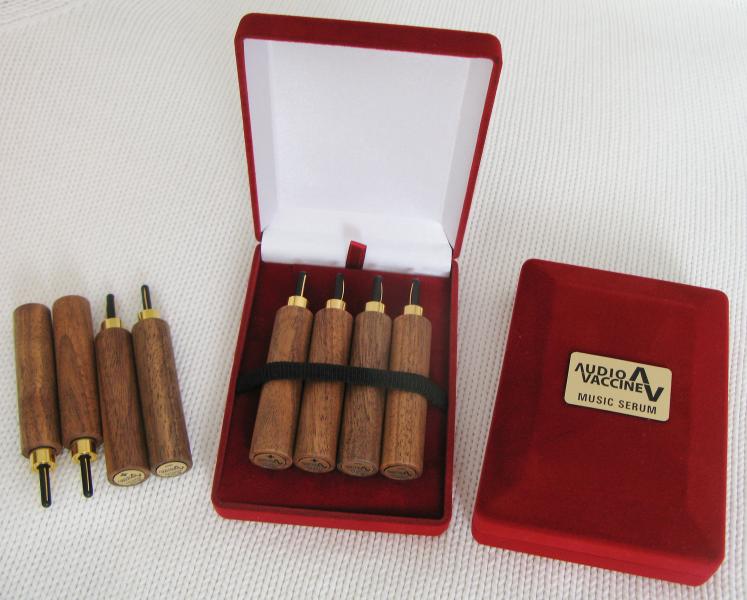
The newest tweak arriving here – and the subject of this review – comes from a new company called Audio Vaccine of Slovenia. The Music Serum was designed by Igor Macek, an audiophile and die-hard tweaker himself. These miniature, rounded wooden sticks, designed to be applied to the amplifier and loudspeaker binding posts, are claimed to remove noise and distortions you never realized existed in your system. Music Serums are sold in sets of four and retail for $900 per set. Macek cautions that you will need two sets to get the ultimate benefits. For this review, he sent me two sets covering both speaker and amplifier terminals for both channels.
Being a music lover and a tweaker by nature, Macek’s goal in inventing the Music Serum was to attract that potential customer away from buying a new loudspeaker system or amplifier, and to show them how much better their existing system can sound. The money saved can be used for better things: like new music.
Originally intended to remove various types of EMI/RFI, the Music Serums came to fruition after years of costly trail and error. After many failed experiments, aspecial mixture of precious metals and hardwood offered the results he was after. Macek emailed me that his Music Serums worked “better than advertised” regardless of the monetary value or peer status of the stereo system.
In form, the Music Serums reminded me of Bybee Super Effect Speaker Bullets. Smaller and lighter and much less expensive (Speaker Bullets retail for $5,500 a set) the Music Serums are manufactured in two versions: MS Speaker (gold only) and MS Amp (gold or rhodium). They come with banana or spade connections. Their exterior is made of birch wood, which Macek claims contributes to a “more natural” sound.
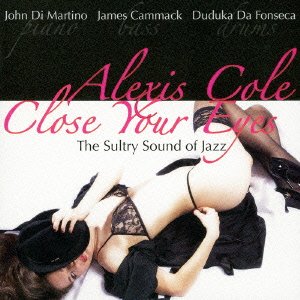 I first installed the MS Amp plugs on the designated positive (+) and negative (-) binding posts of my G9 Nero monoblock tube amplifiers, a simple and straightforward operation. The loudspeakers I used are the Audience ClairAudient 1+1 monitors, just reviewed. Tuning up the soulful, sultry voice of Alexis Cole from her new jazz CD entitled “Close Your Eyes,” (purchased from Hajami Sato’s on-line store, Eastwind Import) proved a pleasant surprise. Alexis Cole, with whom I was unfamiliar, can really, really sing and her trio (John Di Martino, piano, James Cammack, bass and Duduka Da Fonseca, drums) provide stellar performances on all twelve tracks. Intimate, relaxed and resoundingly vibrant, Alexis Cole sings—like she owns—such timeless classics as You Don’t Know What Love Is and In The Still of The Night. This band breathes a new sense of life and vibrancy into this music. I had to spend forty-five minutes trying to get past how great a find this disc is—it has excellent sound quality too—before I could concentrate on the effects of the Music Serums (which I had burned in for a recommended 150 hours).
I first installed the MS Amp plugs on the designated positive (+) and negative (-) binding posts of my G9 Nero monoblock tube amplifiers, a simple and straightforward operation. The loudspeakers I used are the Audience ClairAudient 1+1 monitors, just reviewed. Tuning up the soulful, sultry voice of Alexis Cole from her new jazz CD entitled “Close Your Eyes,” (purchased from Hajami Sato’s on-line store, Eastwind Import) proved a pleasant surprise. Alexis Cole, with whom I was unfamiliar, can really, really sing and her trio (John Di Martino, piano, James Cammack, bass and Duduka Da Fonseca, drums) provide stellar performances on all twelve tracks. Intimate, relaxed and resoundingly vibrant, Alexis Cole sings—like she owns—such timeless classics as You Don’t Know What Love Is and In The Still of The Night. This band breathes a new sense of life and vibrancy into this music. I had to spend forty-five minutes trying to get past how great a find this disc is—it has excellent sound quality too—before I could concentrate on the effects of the Music Serums (which I had burned in for a recommended 150 hours).
The more I listened, the more I liked what I was hearing. I noticed an improvement in the overall PRaT (Pace, Rhythm and Timing). Adding the Music Serums seemed to bring about a more percussive, and at the same time a more delicate presentation. I also got the sense of improvement in the high frequencies, particularly in the glistening shimmer of cymbals and strings. The added translucency of the already super-transparent 1+1s was slowly becoming more obvious. As Macek had commented, the sweetness seemed to derive from an even lower and darker noise floor, the stark contrast of instruments against a inky black background. Everything sounded cleaner and clearer with improved sound-staging and three-dimensionality.
Removing the MS plugs reduced that sense of the musicians actually floating between the loudspeakers. PRaT noticeably diminished. Three dimensionality was less stellar and the sound-stage was no longer as wide. Changes I heard in removing the Music Serums were actually more noticeable than those I heard after installing them.
I was excited to discover what installing the set of Music Serum Speaker plugs would do for the sound. For $900 dollars, I think they would impress everyone I know who loves music as much as I do.
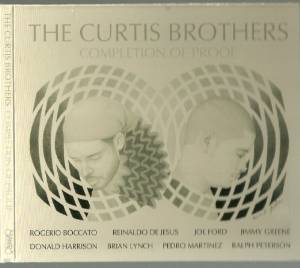 Installing the four Music Serum Speaker plugs on the ClairAudient 1+1s—keeping a close eye on polarity—took me less than two minutes. I tuned up the La Rosita Music Server, went to my dining room seat, and played some good old familiar music. The Curtis Brothers “Completion of Proof” is some pretty serious, straight-away ’60s-style jazz. This contemporary (2011) melodic fury is reminiscent of Art Blakey and his Jazz Messengers. Masterpiece is a blistering cut and one of my favorite tracks; it excites the soul with its tight and fast harmonious tempo that’s punctuated with furious solo performances. With both sets of the Music Serums in place, the music possessed even greater focus, while front to back layering reached further out, and with no sense of exaggeration. Bass was even tighter and more sure-footed. I was somewhat overwhelmed because I found these little Audience ClairAudient 1+1 monitors were more dynamic than I would have believed.
Installing the four Music Serum Speaker plugs on the ClairAudient 1+1s—keeping a close eye on polarity—took me less than two minutes. I tuned up the La Rosita Music Server, went to my dining room seat, and played some good old familiar music. The Curtis Brothers “Completion of Proof” is some pretty serious, straight-away ’60s-style jazz. This contemporary (2011) melodic fury is reminiscent of Art Blakey and his Jazz Messengers. Masterpiece is a blistering cut and one of my favorite tracks; it excites the soul with its tight and fast harmonious tempo that’s punctuated with furious solo performances. With both sets of the Music Serums in place, the music possessed even greater focus, while front to back layering reached further out, and with no sense of exaggeration. Bass was even tighter and more sure-footed. I was somewhat overwhelmed because I found these little Audience ClairAudient 1+1 monitors were more dynamic than I would have believed.
One afternoon my good friend, music lover and neighbor Barry stopped over for a listen. I took him right into my dining room (which has my smaller rig), instead of upstairs and sat him right down. Being so used to big rigs, he looked and said “okaaaaaay?” After about 15-minutes and three songs, he thought this was the most awe-inspiring sound he had heard from such a small and unimposing set up. He didn’t stop talking about the soundstaging for weeks. I’ve always loved the sound of G9 products, regardless of the attached loudspeakers. But the Music Serums took the sound a solid step closer to what we all are striving for: greater musical enjoyment.
Music Serum versus the Bybee Bullets
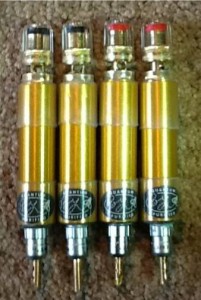 Comparing the Music Serums to the far more expensive Bybee Speaker Bullets was not something I didn’t want to do because of the price differences (The Bybees are $5500 for a set of four). But because they work in a similar manner I just had to give them a try in the upstairs big rig. But first, I listened with the Speaker Bullets removed. And I will state here for the record: removing the Speaker Bullets showed me immediately why I have been using and admiring this product so very much. Apparent from the first note of the Curtis Brothers Madison CD was loss in image density and dynamic intensity. The system sounded rather shallow and uninvolving like it lost resolution. Installing both sets of the Music Serums on the Behold BPA-768 amplifiers and Sunny Majestic horn loudspeakers bought the sound quality back to its previous level to some degree. There was dynamic swing and the bass wasn’t nearly as thick. The space surrounding images stood out amidst a bigger and more vibrant soundstage. But image density wasn’t the same. Nor was the system as resolute sounding. The Bybee Speaker Bullets a visceral sense of bass prowess that I have grown accustomed to. Here I found that was somewhat lacking.
Comparing the Music Serums to the far more expensive Bybee Speaker Bullets was not something I didn’t want to do because of the price differences (The Bybees are $5500 for a set of four). But because they work in a similar manner I just had to give them a try in the upstairs big rig. But first, I listened with the Speaker Bullets removed. And I will state here for the record: removing the Speaker Bullets showed me immediately why I have been using and admiring this product so very much. Apparent from the first note of the Curtis Brothers Madison CD was loss in image density and dynamic intensity. The system sounded rather shallow and uninvolving like it lost resolution. Installing both sets of the Music Serums on the Behold BPA-768 amplifiers and Sunny Majestic horn loudspeakers bought the sound quality back to its previous level to some degree. There was dynamic swing and the bass wasn’t nearly as thick. The space surrounding images stood out amidst a bigger and more vibrant soundstage. But image density wasn’t the same. Nor was the system as resolute sounding. The Bybee Speaker Bullets a visceral sense of bass prowess that I have grown accustomed to. Here I found that was somewhat lacking.
As in life, you ususally get what you pay for. The Music Serums are no exception. At $900 per set versus $5,500 per set, they are very far apart pricewise. And considering what they accomplish musically, the Music Serums are certainly more than worth their asking price.
Conclusion
In the final analysis, an audiophile’s journey is limited by financial constraints. Most folk I know do not own Bybee Bullets because of the extravagant asking price. But if you’ve always wanted an affordable alternative that’s close to their performance, I do not think you will go wrong purchasing the Audio Vaccine Music Serums. I recommend starting with the MS Amp (I find the gold a tad richer and more involving than the somewhat brighter and faster-sounding rhodium). Then, if you like what the MS gold does, you can invest in another set. I found having both Music Serums on both the amplifiers and the loudspeaker provided the best sonic experience. But, that also doubles the price.
The Audio Vaccine Music Serums transformed my downstairs system into a music machine that performs well beyond its size and sophistication. In fact, I purchased both sets of Music Serum plugs! Highly recommended.


clement perry
Audio Vaccine Music Serum
Price: $900 per set (4)
US importer: Tweekgeek
Website: www.tweekgeek.com/audio-vaccine/
Stereo Times Masthead
Publisher/Founder
Clement Perry
Editor
Dave Thomas
Senior Editors
Frank Alles, Mike Girardi, Key Kim, Russell Lichter, Terry London, Moreno Mitchell, Paul Szabady, Bill Wells, Mike Wright, Stephen Yan, and Rob Dockery
Current Contributors
David Abramson, Tim Barrall, Dave Allison, Ron Cook, Lewis Dardick, Dan Secula, Don Shaulis, Greg Simmons, Eric Teh, Greg Voth, Richard Willie, Ed Van Winkle, and Rob Dockery
Music Reviewers:
Carlos Sanchez, John Jonczyk, John Sprung and Russell Lichter
Site Management Clement Perry
Ad Designer: Martin Perry





Be the first to comment on: Audio Vaccine Music Serum